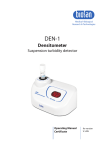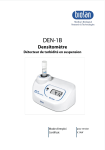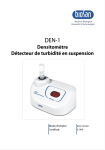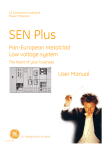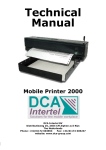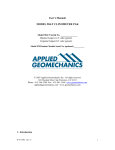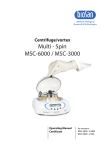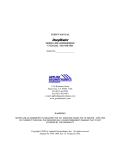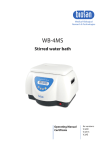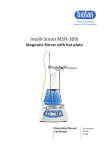Download DEN-1B - User manual
Transcript
Medical–Biological Research & Technologies Densitometer DEN-1B suspension turbidity detector Operating Manual Certificate for version V.1AW Contents 1. Safety Precautions 2. General Information 3. Getting Started 4. Operation 5. Specifications 6. Maintenance 7. Warranty and Claims 8. Declaration of Conformity Page 3 1. Safety Precautions The following symbol means: Caution: Make sure you have fully read and understood the present Manual before using the equipment. Please pay special attention to sections marked by this symbol. GENERAL SAFETY · Use only as specified in the Operating Manual provided. The unit should be saved from shocks and falling. · After transportation or storage keep the unit under room temperature for 2-3hrs · before connecting it to the electric circuit. Use only cleaning and decontamination methods recommended by the · manufacturer. Do not make modifications in design of the unit. · ELECTRICAL SAFETY · Connect only to a external power supply unit with voltage corresponding to that on the serial number label. · Use only the external power supply unit provided with this product. · Ensure that the power switch and external power supply are easily accessible during use. · Disconnect the unit from the external power supply unit before moving. · If liquid penetrates into the unit, disconnect it from the external power supply unit and have it checked by a repair and maintenance technician. · Batteries Use alkaline (preferred) or rechargeable AA type batteries. ATTENTION DANGER, risk of explosion and burns: · The batteries must be inserted correctly with respect to polarity by following the diagram in the battery case. · If one battery is reversed (two + poles or two - poles in contact with each other), a chemical reaction is produced in minutes that releases explosive gasses and extremely corrosive liquid. · In case of doubt, turn off the unit immediately and check the polarity. · Protect your eyes in case a leakage is detected. Cover the battery case with a rag before opening it to avoid contact with any discharge. Page 4 · In case of contact with liquid from the batteries, rinse the affected area immediately with clear water and get immediate medical attention. · Do not mix brands of batteries. · Do not mix new and used batteries. · Remove the batteries from the unit for prolonged storage. · Do not recharge alkaline batteries. · Do not short-circuit the batteries as this can cause burns. · Do not attempt to open or dismantle batteries. · Do not put used batteries in a fire. · Keep batteries out of reach of children. · Keep water out of the battery case. · Follow the disposal instructions and properly dispose of the used battery. DURING OPERATION Do not operate the unit in environments with aggressive or explosive chemical · mixtures. Do not operate the unit if it is faulty or has been installed incorrectly. · Do not use outside laboratory rooms. · · The Select and Install buttons are used only for calibration of the unit according to p. 3.4. Do not press the buttons in other cases, as this can cause calibration reset and recalibration will be needed. BIOLOGICAL SAFETY · It is the user's responsibility to carry out appropriate decontamination if hazardous material is spilt on or penetrates into the equipment. Page 5 2. General Information DEN-1B Densitometer is designed for solution turbidity measurement in the range of 0.0 - 6.0 McFarland units (0 cells/ml - 1800x106 cells/ml). DEN-1B is capable of measuring solution turbidity in a wider range (6.0 - 15.0 McFarland units) however, it is necessary to remember that in this case the standard deviation values increase. DEN-1B Densitometer is used for 1) determining concentration of cells (bacterial, yeast cells) in the fermentation process, 2) detection of susceptibility of microorganisms against antibiotics, 3) identification of microorganisms with various test systems, 4) measuring optical density at fixed wavelength and 5) quantitative evaluation of concentration of dyed solutions that absorb green light. The operation principle is based on optical density measurement with digital result representation in McFarland units. The unit is calibrated at the factory and saves calibration data when being switched off. However, in can be calibrated by 2-8 points in 0.0 - 6.0 McFarland unit range if necessary. Both commercial standards (e.g. produced by BioMerieux, Lachema, etc.) and the cell suspensions prepared in the laboratory can be used for calibration. Table 1. Interpretation of McFarland Standard results into corresponding numeric values of bacterial suspension concentration and their optical density at 550 nm. McFarland Standard 0.5 1 2 3 4 5 6 Composition Concentration BaSO4 2.40x10-5 mol/l 4.80x10-5 mol/l 9.60x10-5 mol/l 1.44x10-4 mol/l 1.92x10-4 mol/l 2.40x10-4 mol/l 2.88x10-4 mol/l Interpretation Bacterial Theoretical optical concentration* density at 550 nm** 150x106 cells/ml 0.125 300x106 cells/ml 0.25 600x106 cells/ml 0.50 0.75 900x106 cells/ml 1.00 1200x106 cells/ml 1.25 1500x106 cells/ml 1.50 1800x106 cells/ml * Bacterial concentration depends on microorganism size. The numbers represent an average value valid for bacteria. For yeasts, which are larger in size, these numbers should be divided by about 30. ** Values correspond to optical densities of bacterial suspensions. The BaSO4 solutions optical density values differ, because the particle size and form differ from those of bacteria and light is diffracted differently. Page 6 3. Getting started 3.1. Unpacking Remove packing materials carefully and retain them for future shipment or storage of the unit. Examine the unit carefully for any damage incurred during transit. The warranty does not cover in-transit damage. 3.2. Complete set. Package contents: Standard set DEN-1B Densitometer suspension turbidity detector ...........................1 piece AA type battery...................................................................................3 pieces external power supply unit ...................................................................1 piece Operating Manual, Certificate ...............................................................1 copy Optional accessories A-16 adapter for tubes.....................................................................on request CKG16 calibration kit for glass tubes 16 mm in diameter ..................on request CKG18 calibration kit for glass tubes 18 mm in diameter ..................on request 3.3. Set up: · Battery set up: Insert a flat sharp pin into the small socket according to the fig.1/1 on the underside and open the battery compartment. Insert the batteries inside as shown on the installation scheme in the battery compartment. Place the unit on the horizontal even working surface; · · Alternatively connect the external power supply unit to the socket (fig.2/2) on the rear side of the unit. 1 Fig.1 Bottom panel Page 7 3.4. Calibration The device is pre-calibrated at the factory for operation with the glass tubes 18 or 16 mm in external diameter (see the label on the bottom side of the unit) at temperature range from +15°C to +25°C and saves calibration data when being switched off. Note! For work with other type tubes (e.g. with different outer diameter, bottom shape or different material [transparent plastic tubes]) it is necessary to perform calibration in the specified tubes. Perform calibration in the following sequence from the lower calibration value to the higher values: 0.0, 0.5, 1.0, 2.0, 3.0, 4.0, 5.0, 6.0. Use at least 2 points for calibration. Attention! Make sure that the tube socket is empty! 3.4.1. If the external power supply unit is used, connect it to electric circuit. 3.4.2. Switch ON the unit using the Power switch (Fig.2/1) on the rear panel (position I). 3.4.3. Press the Select button (fig.2/3) on the backside of the unit (use a thin pin with maximum diameter of 2 mm to press the Select and Install buttons).A flashing "- - -" indication will be shown on the display, showing that the unit is ready to save calibrations value of the first calibration point - the empty socket. 3.4.4. Press the Install button (fig.2/4), the empty socket calibration value will be saved in the unit memory and the next calibration value is displayed (flashing figure "0.00”). Note! Shake the tube with the standard solution, if necessary (it is recommended to use vortex, e.g. Personal Vortex V-1 plus, for shaking). 3.4.5. Insert the tube with the standard solution, corresponding to the calibration point value, into the socket (fig.3/1) of Densitometer. 3.4.6. Press the Install button. This calibration curve value will be saved in the memory and the next calibration value will be displayed. Note! It is recommended to calibrate 0 value and as many points as possible to obtain precise results. The minimum requirement is to calibrate 2 points closest to the working range limits (e.g. 0 and 6.0 for operation in 0 - 6.0 McF unit range). 3.4.7. Repeat steps 3.4.5.-3.4.6. until the calibration is complete (1-7 times, i.e. as 1 2 3 4 Power DC-12 Calibration select install Fig.2 Rear panel Page 8 many times as many points the chosen calibration curve has). 3.4.8. If a standard is not available, press the Select button for the next calibration value to be displayed. 3.4.9. After installing the last standard value “6.0”, or skipping it (by pressing the Select button), the will exit the calibration mode automatically. The unit is ready for operation. Note! If pressing the Install button during the calibration process does not cause switching to the next standard value, it means that the currently inserted in the densitometer socket standard has lower turbidity value than the previous standard. The reason is that the inserted standard solution turbidity does not correspond to the required value (the standard is to be shaken or replaced). 3.5.10. After finishing the calibration switch OFF the unit using the Power switch (position O). If an external power supply is used, disconnect the external power supply unit from electric circuit. 4. Operation Recommendations during operation · Remove the tube with the solution being measured before switching the unit on or off. · It is recommended to keep the unit switched on for 15 min before starting the operation in order to stabilize it in the working mode. · If flat-bottomed tubes are used, the solution level should be higher than 7 mm from a tube bottom; if round-bottomed tubes are used, the level should be higher than 12 mm from a tube bottom. · The display goes off if there is no tube in the socket during one minute. Press the On key (fig.3/3) to activate the unit. 1 3 2 On Fig.3 General view Page 9 4.1. If an external power supply unit is used, connect it to electric circuit. 4.2. Switch ON the unit using the Power switch (Fig.2/1) on the rear panel (position I). 4.3. The following indication may be shown on the display (fig.3/2): “0.00” means that the unit is calibrated and ready for operation (if no tube inserted); “CC”(flashing) means that the unit is not calibrated. Calibrate the unit. ‘LOW BATTERY’ means that change the batteries following the instructions of the Safety Precautions section concerning batteries. 4.4. Shake the tube with the solution (it is recommended to use a vortex for shaking, e.g. V-1 plus personal vortex) and insert it into the socket of Densitometer (fig.3/1). The McFarland value for the solution will be shown on the display (fig.3/2). 4.5.Glass and transparent plastic tubes (16 or 18 mm in external diameter) can be used for work with densitometer. An A-16 adapter must be inserted in the socket when working with tubes which have external diameter 16 mm. Note! The unit must be calibrated each time a tube type (e.g. with different outer diameter, bottom shape or different material [transparent plastic tubes]) is changed. 4.5. After finishing the operation switch OFF the unit using the Power switch (position O). If the external power supply unit is used, disconnect it from electric circuit. Page 10 5. Specifications The unit is designed for operation in cold rooms, incubators and closed laboratory rooms at ambient temperature from +4?C to +40?C and maximum relative humidity 80% for temperatures up to 31°C decreasing linearly to 50% relative humidity at 40°C. 5.1. Light source ..................................................................................................LED 5.2. Wavelength ..................................................................................ë = 565 ±15 nm 5.3. McFarland unit range ............................................................................0.0 - 15.0 5.4. Display resolution..................................................................................0.01 McF 5.5. Accuracy, of the full scale..............................................................................+ 3% 5.6. Measurement time ......................................................................................1 sec 5.7. Sample volume ..............................................................................2 ml minimum 5.8. Recommended external diameter of tube ..................................................18 mm or using A-16 adapter 16 mm 5.9. Display ........................................................................................................LCD 5.10. Dimensions .............................................................................165x115x75 mm 5.11. Input current/power consumption ...........................................12 V, 7 mA / 0.1 W 5.12. External power supply unit ......input AC 100-240 V 50/60 Hz, output DÑ 12 V 5.13. Battery..............................................................................3 x batteries AA type 5.14. Weight* ....................................................................................................0.7 kg * Accurate within ±10%. Optional accessories Description Catalogue number A-16 Adapter for tubes 16 mm in external diameter BS-050102-AK CKG16 Calibration kit for glass tubes 16 mm in diameter Calibration kit for glass tubes 18 mm in diameter BS-050102-BK CKG18 BS-050102-CK Biosan is committed to a continuous programme of improvement and reserves the right to alter design and specifications of the equipment without additional notice. Page 11 6. Maintenance 6.1. If the unit requires maintenance, disconnect the unit from the electric circuit and contact Biosan or your local Biosan representative. 6.2. All maintenance and repair operations must be performed only by qualified and specially trained personnel. 6.3. Standard ethanol (75%) or other cleaning agents recommended for cleaning of laboratory equipment can be used for cleaning and decontamination of the unit. Page 12 7. Warranty. Reclamation information 7.1. The Manufacturer guarantees the compliance of the unit with the requirements of Specifications, provided the Customer follows the operation, storage and transportation instructions. 7.2. The warranted service life of the unit from the date of its delivery to the Customer is 24 months. Contact your local distributor to check availability of extended warranty. 7.3. If any manufacturing defects are discovered by the Customer, an unsatisfactory equipment claim shall be compiled, certified and sent to the local distributor address. Please visit www.biosan.lv, Technical support section to obtain the claim form. 7.4. The following information will be required in the event that warranty or postwarranty service comes necessary. Complete the table below and retain for your records. Model Suspension turbidity detector Densitometer DEN-1B Serial number Date of sale Page 13 8. Declaration of Conformity Page 14 Biosan SIA Ratsupites 7, build. 2, Riga, LV-1067, Latvia Phone: +371 6742 6137 Fax: +371 6742 8101 http://www.biosan.lv Version 1.04 - October 2013
















